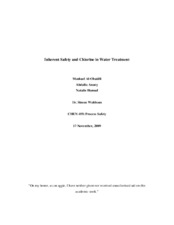| dc.description.abstract | Chlorine has been used for water treatment purposes for more than one hundred
years. The simplicity and effectiveness of using chlorine and its derivatives for water
treatment is one of the wonders of modern chemistry: it is cheap, it is safe, and it works.
Chlorine has uses on water intake structures, for the removal of aquatic organisms, for
pre-filtration, to kill bacteria and for water disinfection. The gas has a greenish-yellowish
color and has a molecular weight that is two and a half times larger than that of air. In its
gaseous form, chlorine is extremely toxic and dangerous. It also has a very high
coefficient of expansion. For this reason, all chlorine containers’ volume must not be
filled up past eighty five percent of their capacity. Chlorine gas is fed into the water
treatment system under vacuum conditions. Chlorine tanks have an automated system of
regulators, feed equipment and vacuum ejectors. Piping connections must be sealed with
proper pipe thread compound and compression fittings must be sealed with a new lead
washer. Also, chlorine gas scrubbers should be installed in any facility that uses chlorine
gas. The Environmental Protection Agency (EPA) requires wastewater plants which
store two-thousand five-hundred pounds or more of chlorine gas to conduct a risk
management plan. Risk reduction begins with using the smallest cylinders possible of
chlorine gas for the application. Water treatment plants can manifold as many ton
containers as necessary while controlling for leaks at each individual container and
throughout the entire system. In addition, the water plant should be located as far out of
the city as possible, downwind of the prevailing winds. Booster systems at strategic
locations can be placed. The Pasquill-Gifford model is a very good way to estimate the
concentrations of a release at different distances from the source. However, a better
Al-Obaidli, Anany, Hamad 3
3
model to use would be the Britter and McQuaid model for dense gases. Risk assessment
software such as PHAST provides planners and retrofitters with a tool to determine
various levels of risk. The example used about Ras-Laffan was simulated using PHAST
for the three cases involved. The companies at Ras-Laffan assume that the wind direction
from that region will always be North-West. If that were true, then the results from
PHAST show that there would be no risk of the leak reaching any of the surrounding
cities. The rupture of a one- ton cylinder could potentially produce a cloud one mile high
by a half- mile wide by one mile long of toxic mustard gas that will kill everything in its
wake. A train in Ontario derailed and a tank car of chlorine gas ruptured; if there had not
been a large propane fire funneling the heavier-than-air mustard gas upwards into the
atmosphere, many thousands of people in the city of Mississauga might have died.
Although chlorine is by far the cheapest chemical to use for water treatment, the most
widely accepted, and has the fewest risks to public health, other chemicals should also be
investigated | en |




